|
September 24, 2021 - No. 87
Quebec Government Poised to Dismantle Occupational
Health and Safety Regime
Workers and Their Unions Demand Withdrawal of Anti-Worker
Anti-Social Bill 59

• Interview
- Julie Hébert, Health, Safety and Environment Coordinator,
Syndicat des Métallos/United Steelworkers
Repeal Ontario's Bill 124! Increase Funding for Health Care!
• Arbitration Decision in Nurses' Bargaining Will Deepen Crisis of Recruitment and Retention
Quebec Government Poised to Dismantle Occupational
Health and Safety Regime
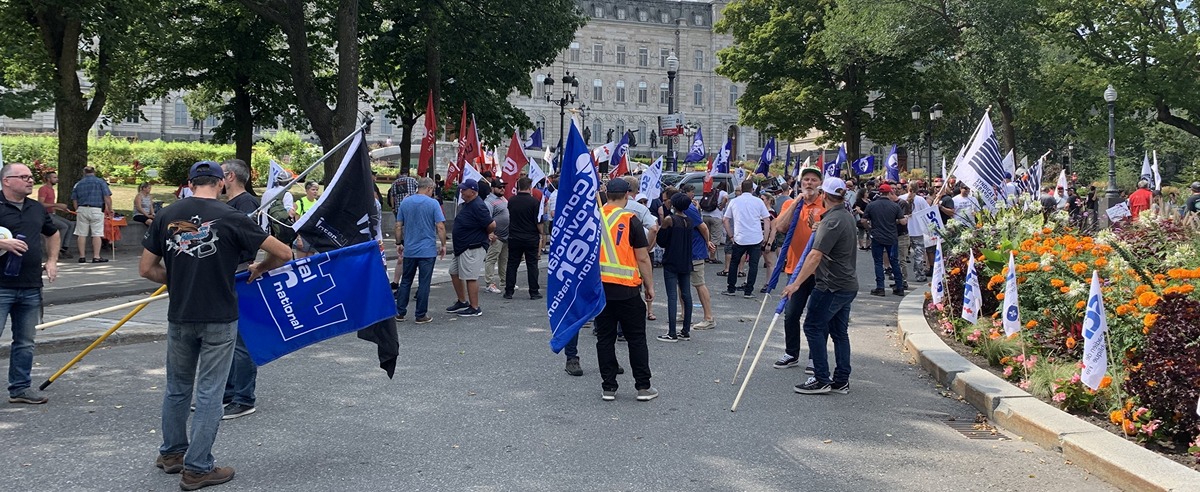
Action against Bill 59 at National Assembly, August 26, 2021
Despite strong opposition from workers, their
unions and
injured workers' organizations, the Quebec government is preparing
to pass Bill
59, An
Act to modernize the occupational health and safety regime,
as the
Quebec National Assembly committee charged with clause by clause study of the legislation has
completed its work.
The bill openly treats workers' health and safety as a cost that
must be
reduced for those who buy workers' capacity to work, including a
full-scale
attack on treatments of injuries, rehabilitation and compensation.
It also excludes
the voice of workers from
decision-making
about prevention in the workplace.
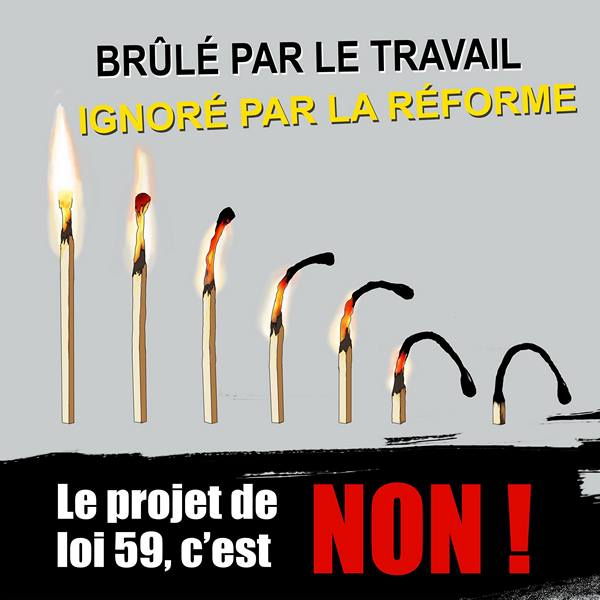 With
great hypocrisy, Labour Minister Jean Boulet stated in committee that
granting all decision-making power to employers is intended to
strengthen the accountability of employers, since they are ultimately
the ones who are responsible for ensuring the necessary prevention
programs in workplaces! By attacking workers' medical treatment
and compensation, the bill affirms that workers are disposable as far
as the narrow private interests that control the economy are concerned.
Construction workers have also pointed out that the attacks on
prevention come at a time when a labour shortage is being invoked to
open up job sites en masse
to a workforce that more and more is not being given the necessary
training to ensure their safety. Workers who leave the industry because
of the poor working conditions, including lack of safety, can easily be
replaced by workers who lack proper training and this never ends.
Treating workers as disposable increases the dangers for all workers. With
great hypocrisy, Labour Minister Jean Boulet stated in committee that
granting all decision-making power to employers is intended to
strengthen the accountability of employers, since they are ultimately
the ones who are responsible for ensuring the necessary prevention
programs in workplaces! By attacking workers' medical treatment
and compensation, the bill affirms that workers are disposable as far
as the narrow private interests that control the economy are concerned.
Construction workers have also pointed out that the attacks on
prevention come at a time when a labour shortage is being invoked to
open up job sites en masse
to a workforce that more and more is not being given the necessary
training to ensure their safety. Workers who leave the industry because
of the poor working conditions, including lack of safety, can easily be
replaced by workers who lack proper training and this never ends.
Treating workers as disposable increases the dangers for all workers.
On September 21, the Quebec Federation of Labour (FTQ) voted
unanimously at its executive meeting to call for the withdrawal of Bill
59. The QFL is the largest central labour organization in Quebec and
represents the majority of industrial workers in Quebec, while also
being widely represented in the public sector. On its board sit
representatives of a large number of affiliated unions, including
United Steelworkers, FTQ-Construction, Unifor, Teamsters, United Food
and Commercial Workers, Canadian Union of Public Employees, Canadian
Union of Postal Workers, Public Service Alliance of Canada,
International Association of Machinists and Aerospace Workers and many
others. The Congress of Democratic Trade Unions (CSD) is also calling
for the rejection of Bill 59. The Confederation of National Trade
unions (CSN) and the Centrale des syndicats du Québec also
denounce Bill 59 as unacceptable.
Workers are considering what actions to take to ensure that Bill 59 does not pass.

- Julie Hébert, Health, Safety and Environment Coordinator,
Syndicat des Métallos/United Steelworkers -
Workers' Forum: What are the main changes that Bill 59 brings to the occupational health, safety and prevention regime?
Julie Hébert: At the moment, we have a
regime that includes four prevention mechanisms. In the original 1979
law, it was foreseen that each workplace would have a health and safety
committee, one or more prevention representatives, a prevention program
and a health program. Over time, for various reasons,
these mechanisms have only been applied to 12 per cent of workplaces.
The sectors of the economy were separated into six different workplace
categories. Only in two of them, known as sectors one and two, were all
of these prevention mechanisms applied.[1] What the Steelworkers and the entire labour movement have been calling for is the extension of these prevention
mechanisms to all workplaces, so that prevention could be carried out
everywhere equally. Time has shown that these mechanisms work well in
the workplaces where they were applied, certainly in those represented
by the Steelworkers.
But that is not what Bill 59 does.
The bill eliminates the health program in the workplace. This was a
program in which there was intervention from Public Health and a
physician responsible for health care in the facility. That no longer
exists.
The second point is the prevention program that was submitted to the
Health and Safety Committee for approval and was also developed with
Public Health and the physician in charge. This program is now the sole
responsibility of the employer. There is no longer joint approval by
the health and safety committee.
Thirdly, the health and safety committees lose their ability to act
because this is diluted by the provision that an employer can create a
single health and safety committee for several establishments. The
bill is not clear on this subject, as it uses the criterion of the
nature of the employer's activities. For example, a mining company that
has
different facilities for refining, casting and other activities could
say that the nature of all these activities is the same and therefore
have a single health and safety committee for several establishments.
This is because the criterion in the bill is not clear.
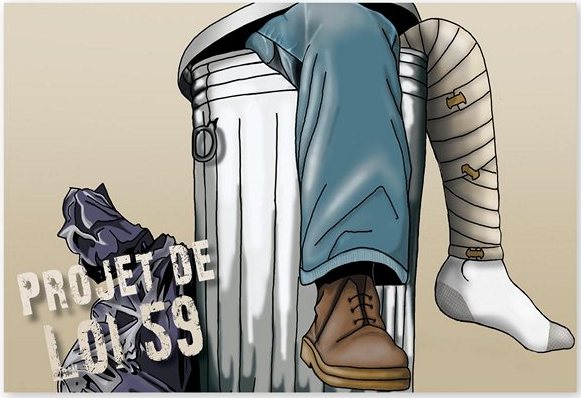 The
last thing, which is probably the most serious, is that it takes away
prevention representatives' ability to act. In the original law, it
was the prevention representatives who were responsible for contact
with the workers. In the present law, in groups one and two, it is the
prevention representatives who are responsible for what is referred
to as work on the shop floor, of being in contact with the workers,
representing them, helping them exercise their rights. This is
extremely important work that is done every day in Quebec, that is, in
the 12 per cent of workplaces where this prevention representative
mechanism presently applies. Apart from the issue of
multi-establishments, the bill
removes all the minimums that were provided for, whether it be the
frequency of health and safety committee meetings or the minimum number
of hours that prevention representatives are released from work to
carry out these duties. At the moment there are minimums, or a scale,
so that for a given number of workers, prevention representatives are
mandated so many hours of release, and a minimum of one, two or three
prevention representatives are mandated based on the number of workers,
etc. This no longer
exists. This will now be determined through an agreement between the
parties. The unions will have to come to an agreement with the employer
to negotiate release time for their prevention representatives. We will
end up having to negotiate workplace prevention. The
last thing, which is probably the most serious, is that it takes away
prevention representatives' ability to act. In the original law, it
was the prevention representatives who were responsible for contact
with the workers. In the present law, in groups one and two, it is the
prevention representatives who are responsible for what is referred
to as work on the shop floor, of being in contact with the workers,
representing them, helping them exercise their rights. This is
extremely important work that is done every day in Quebec, that is, in
the 12 per cent of workplaces where this prevention representative
mechanism presently applies. Apart from the issue of
multi-establishments, the bill
removes all the minimums that were provided for, whether it be the
frequency of health and safety committee meetings or the minimum number
of hours that prevention representatives are released from work to
carry out these duties. At the moment there are minimums, or a scale,
so that for a given number of workers, prevention representatives are
mandated so many hours of release, and a minimum of one, two or three
prevention representatives are mandated based on the number of workers,
etc. This no longer
exists. This will now be determined through an agreement between the
parties. The unions will have to come to an agreement with the employer
to negotiate release time for their prevention representatives. We will
end up having to negotiate workplace prevention.
What should have been done is to take what presently applies in the
12 per cent of workplaces and extend it to all workers. Instead, this
has all been diluted, in particular by removing the minimums. This will
be left to negotiation between the parties. If there is no agreement,
there will be legal recourse, leaving it up to the Labour
Standards, Pay Equity and Workplace Health and Safety Board(CNESST ) to
decide on the issue. We remember that mines were real killers for
workers in the 1950s and 1960s. The mining unions will now have to go
to court or to the Administrative Labour Tribunal to make their case as
to why so many prevention representatives and so many release hours are
needed. This is judicialization of the process. This will probably
become one more issue that will have to be negotiated at the bargaining
table, just like wage increases or working conditions.
As well, currently a contaminant register is submitted to the joint
health and safety committee. From now on, the employer will have sole
control over this. The register will no longer be submitted to the
health and safety committee. Workers will no longer know what they are
exposed to in their own workplace. I am a lawyer by training and when I
am involved in occupational disease cases with unions, if the
prevention representative is able to provide me with all the minutes of
the health and safety committee and tell me that for x amount of time
such and such a contaminant has been used in our plant, we were
exposed, it is dangerous, we have made representations to the
employer, -- all of this is evidence that we need to have
work-related diseases recognized that we will now lose. When talking
about health and prevention programs, I mentioned that there is a
physician responsible for health services at the workplace. Currently,
this physician is appointed by the health and safety committee. Now
they will be appointed by the employer.
WF: Do you want to add anything in conclusion?
JH: The most deplorable aspect of Bill 59 is the loss
of contact with the workers on the floor. Nobody knows the situation
better than the prevention representatives. Nobody knows the plants
better. They are there day after day and are in the best position to
help the workers. Also, the parity provisions in the 1979 law are being
eliminated. Full power is given to the employer and we firmly denounce
this.
Note 1. The priority groups one and two in the law where the four prevention mechanisms apply are:
PRIORITY GROUP I
1. Construction and public works;
2. Chemical industry;
3. Forestry and sawmills;
4. Mining, quarrying and oil wells;
5. Metal product manufacturing.
PRIORITY GROUP II
6. Wood industry (without sawmill);
7. Rubber and plastic products industry;
8. Transportation equipment manufacturing;
9. Primary metal processing;
10. Non-metallic mineral product manufacturing.
Although the construction sector is included in these groups, the
provisions of the law regarding the prevention mechanisms have never
been enacted for construction.

Repeal Ontario's Bill 124! Increase Funding for Health Care!
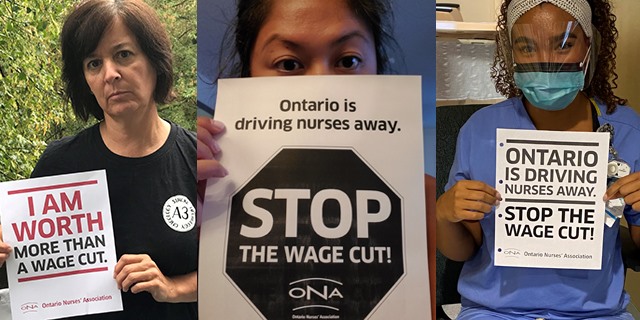
Ontario nurses are fighting for the repeal of Bill 124, the Ford
government's anti-worker legislation that caps compensation increases
to one per cent per year over three years for most public sector
workers.
On September 20 nurses received the decision of an arbitration board
on the terms of the collective agreement between their union, the
Ontario Nurses' Association (ONA) and the Ontario Hospital Association.
Health care workers in Ontario are prohibited by law from striking and
when negotiations fail disputes are taken to a three-person
interest arbitration board, a panel consisting of one member chosen by
the union, one by the employers and a mutually-agreed upon chair.
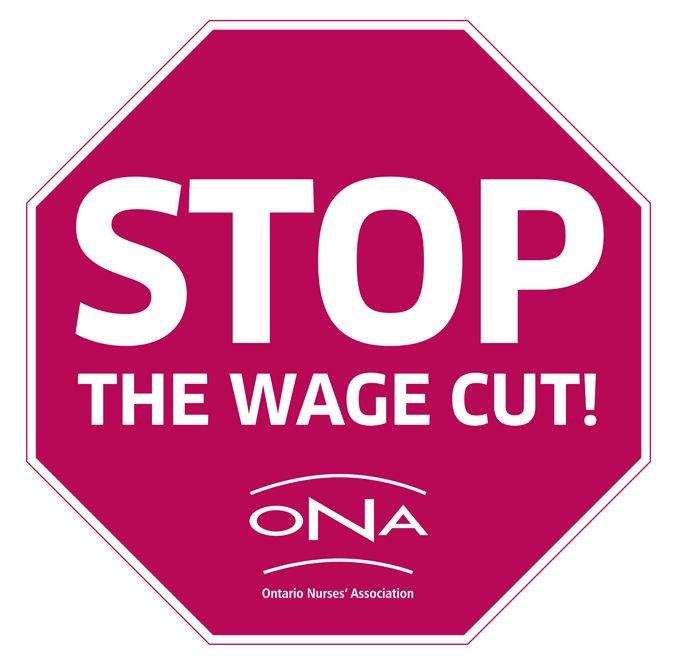 The
arbitration decision denied all the union's proposals for increases in
wages and working conditions that are necessary to solve the problem of
retention and recruitment of nurses, a problem that is now more serious
than ever. In his decision the Chair cited the Ford government's
anti-worker Bill 124 as the reason for rejecting ONA's proposals on
compensation. The union's member of the panel dissented and the
employers' member dissented in part with the decision of the chair. The
arbitration decision denied all the union's proposals for increases in
wages and working conditions that are necessary to solve the problem of
retention and recruitment of nurses, a problem that is now more serious
than ever. In his decision the Chair cited the Ford government's
anti-worker Bill 124 as the reason for rejecting ONA's proposals on
compensation. The union's member of the panel dissented and the
employers' member dissented in part with the decision of the chair.
Proposals from ONA dealt mainly with improvements in health and
safety provisions including timely and adequate provision of PPE based
on the precautionary principle, and increases in compensation for
nurses that are essential both for the well-being of nurses who are
working now but also to solve the crisis of recruitment of new
nurses.
Nurses and all health care workers in Ontario are waging a
determined fight for the repeal of Bill 124 which is being used by
employers and the government to cut wages when inflation is taken into
account. In their submission to the arbitration board ONA forcefully
argued that the crisis in staffing which existed before the pandemic
and has
become unbearable now, requires immediate and significant government
investment in recruitment and improvements needed to retain workers.
They also pointed out that the legislation exempts certain professions
that are male-dominated like firefighters and police, thus increasing
the already existing discrimination against women, a possible
breach of the Human Rights Code.
The union's press release of September 20 quotes ONA president Vicki
McKenna on the situation of the 60,000 nurses affected by the decision:
"Our members have continued to show up and hold the front lines through
the worst health crisis in more than a century. In many cases, they
have not been provided with sufficient personal protective
equipment, have feared for their lives and those of their families, and
many have incurred extra out-of-pocket living expenses to move away
from their families to protect them. This government has taken away
their rights and enabled their employers to send them to other
facilities without their agreement, have been denied time off and have
been
witness to horrors the public cannot imagine as the pandemic raced
through the province. We could not even negotiate improved mental
health benefits because the costs are more than allowable under the
legislation."
The chairperson of the arbitration board stated in his decision that
"Bill 124... limits to a very significant degree what it is even
possible for this board to consider in this round," essentially that
the board's hands are tied, not even permitted to inquire into or
remedy a breach of the Human Rights Code. As well, he notes that "Bill
124 provides
the government with a number of oversight and enforcement mechanisms
including the ability to invalidate an interest arbitration award," so
if the board were to defy the restrictions imposed by Bill 124 their
decision would be overturned.
Over 40 unions have launched a Charter Challenge to Bill 124 which
may well result in its being declared unconstitutional. In the
meantime, as that wends its way through the courts and the staffing
crisis deepens, employers cry poor, complaining about underfunding but
content to put the burden for that on the workers, with Bill 124 as
their
shield.
The government of Ontario has abandoned its responsibility to ensure
that the health care needs of the people are met. Decades of
neo-liberal anti-social cuts, privatization and restructuring have left
the health care system inadequately funded at the best of times,
completely overwhelmed with the added burden of COVID-19. This burden
has
fallen on the shoulders of the workers who have reached their limit and
need relief and support to be able to do their jobs. Anyone can see
that what is needed is immediate increased funding to improve the
conditions of those already working and to train and hire the thousands
of new workers that are needed, providing the current workforce and
new hires with working conditions that are humane, safe and dignified.

(To access articles individually click on the black headline.)
PDF
PREVIOUS
ISSUES | HOME
Website: www.cpcml.ca
Email: office@cpcml.ca
|

